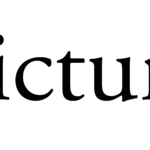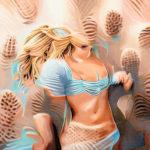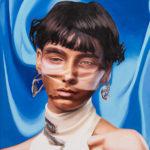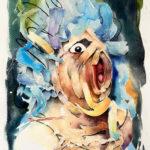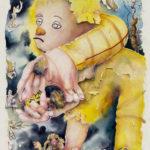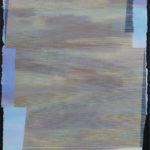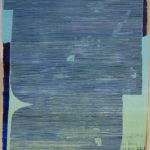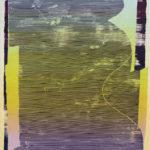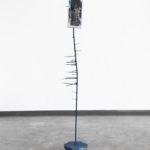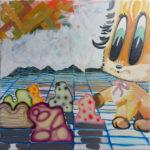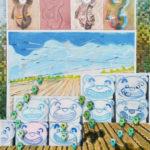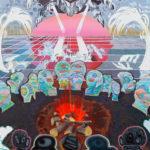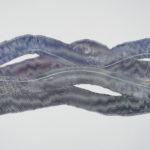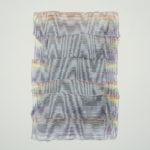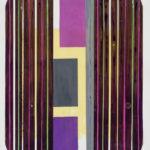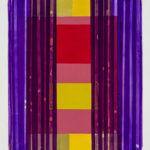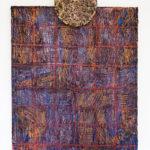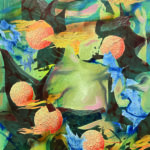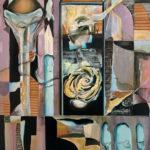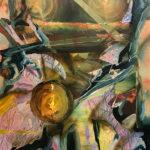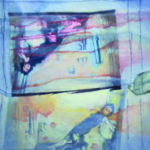Reception: Saturday, November 11, 2023 from 3 p.m. to 5 p.m.
Reverb: Colin Canary, Beth Frey, Ian Gonczarow, Anaïs Goupy, Karine Guyon, Claudia Kleiner, Lauren Pelc McArthur, John Drew Munro, Ianick Raymond, Megan Wade-Darragh
This exhibition is part of the Pictura Triennial
Curator: Trevor Kiernander
Text by Trevor Kiernander
Reverb forms the second chapter in a trilogy of exhibitions planned for Pictura, looking at common threads in painting as they occur in different parts of the world. As an artist first and foremost, I am interested in curating exhibitions through visual connections, and works that resonate with me musically, a personal concern of mine in my own artistic practice.
The first instalment, Echo, took place at Art Mûr in 2020, and brought together a selection of international artists from Leipzig, Berlin, London, Montréal, and Toronto, with each artist dealing with abstraction through their own systems and personal language. Making references and connections to their environment, where images and ideas are bounced around through their process, reflected and reinterpreted, the works reached a point of completion that became part of the entire system once again. The paintings of each artist referenced trace, memory, reflection, and residue – they echoed. Similarly, reverb is an echo effect created electronically in the production of music.
The first inspiration for Reverb, before I had even conceived of this show, came from the work of Lauren Pelc-McArthur. Her paintings are built through layering paint, combining flat, opaque surfaces with elevated, mock-iridescent areas, with sections of colour subtly shifting depending on the viewing angle, and so cannot be photographed accurately, combatting the abundance of “screen friendly” painting, thereby taking control of her viewer. Pelc-McArthur’s overarching aim is to evoke a sensation on a par with compulsively scrolling through train wrecks while experiencing an optical migraine. The titles for these pieces are fabricated words influenced by the Kiki/Bouba effect, where sounds are loosely linked to visual forms.
I began seeing similar sentiments in the works of other painters, some of whom I already knew, and those I met in the subsequent years. Perhaps these were issues being dealt with as per the generation of artists who grew up before the onslaught of the internet and the digital world? What was happening to the public’s understanding of painting and how to view painting? As I would see more exhibitions and meet more artists, relationships began to make themselves apparent, and the exhibition began to take shape. I hope that every painter wants their work to be seen in the flesh, and I feel this group of artists take that into consideration as part of their practice.
Ianick Raymond creates seemingly formal pictorial spaces whose vibrating complexity is revealed as the viewer encounters their materiality. In the unwavering, indistinguishable thread-thin painted lines of Claudia Kleiner’s paintings, the whole is just as important as the parts, a counterpoint, but only visible on the microscopic level, while the macroscopic whole shimmers, again seeming to fight against the possibility of experience the painting fully on one’s digital device: a hand-painted moiré pattern. Using unconventional materials such as ultraviolet, mirror, and metallic pigments as well as glitter, Karine Guyon’s work develops a structure that changes with the slightest movement. Megan Wade-Darragh chooses images that she cannot visually understand, images that evoke confusion and disorientation, aiming for atmosphere over volume and affect over description.
Constantly collecting imagery from news media, screen shots, and other digital sources, Ian Goncharow lets these memories settle and percolate, eventually painting them out using a vast variety of painterly styles, to extend and corrupt the language and the narrative of the original image, harmoniously resembling jumbled collage, direct juxtapositions, or standalone mise-en-scene. Colin Canary trawls images taken from family archives and personal photographs to employ moments of limbs, blurred faces, flowers, and weeds seemingly trapped in fragmentary states, manifesting, and hunting the liminal spaces in between time, in a haunting chorus. John Drew Munro works with collage and paint, utilizing both sides of the translucent surface, reaching a degree of balance combining both harmony and dissonance, creating something unique, utilizing both colour and space.
Carrying forward into the digital realm, Anaïs Goupy’s trompe-l’œil paintings aim to challenge the viewer’s perception of authorship and highlight the objectification of women by neural network-generated imagery, utilizing first-gen AI apps, in the presented paintings of the pop star Britney Spears and socialite Kim Kardashian. The unexpected results highlight how neural networks misrepresent their personas by reducing them to single body parts. Beth Frey’s watercolours are a further extension of a practice into an expansive universe where she herself is often the main character, distorted and morphed through accessible smartphone apps and AI image generation tools, drawing out contradictions in her subject matter, be it gender, the body, or social media.
The struggle to remain fresh, vibrant, and relevant for painters seems to be tougher more than ever these days. The invention of the photograph in the 1800s heralded the first chants of the ‘death of painting’, and throughout history, painting continues to come up against blockades, yet always perseveres. Now with the advancements within the digital world, social media, and now AI, what better way to beat the game by creating something that cannot be viewed properly via the screen? An image that requires a personal viewing to understand its physicality, the way painting should be seen. Reverberation is defined as the phenomenon of the persistence of sound after it has been stopped due to multiple reflections from surfaces within a closed space. The artists in Reverb persist in their respective practices so that you will hear what they are saying.


